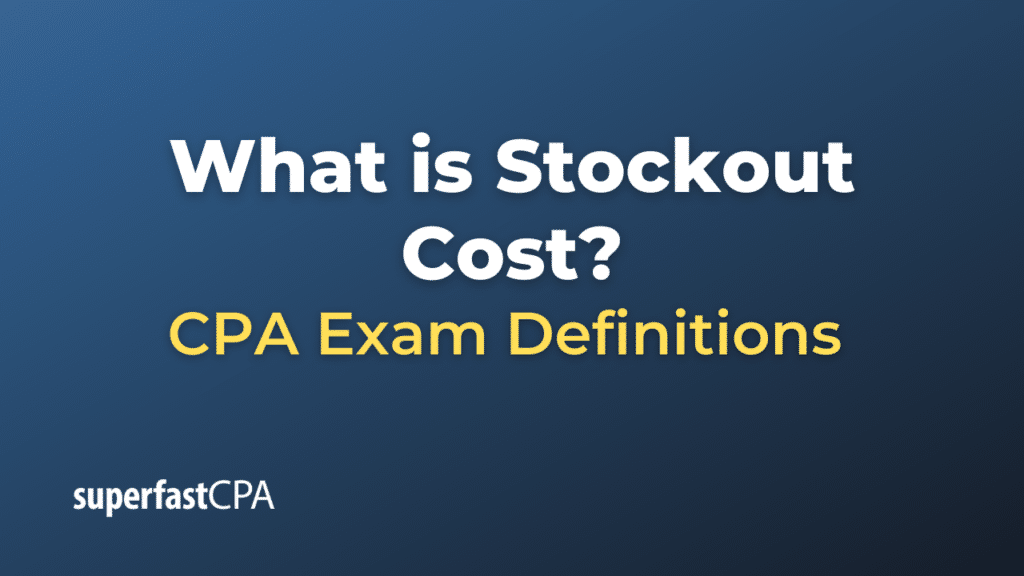Stockout Cost
Stockout cost refers to the costs associated with not having enough inventory to meet demand. When a business runs out of a product (a stockout situation), there are various costs and consequences that can arise, both tangible and intangible. These costs can have a significant impact on a company’s bottom line and reputation.
Types of Stockout Costs:
- Lost Sales Cost: This is the most direct cost. If a customer wants to buy a product and it’s not available, the company loses that sale. Depending on the nature of the product and the customer’s needs, this might be a one-time lost sale, or it might mean the loss of that customer for a longer period.
- Lost Customer Goodwill: When customers encounter stockouts, they might become frustrated or disappointed with the company. If this happens frequently, customers might perceive the company as unreliable, leading to loss of loyalty and possibly causing them to switch to competitors.
- Expedited Order Costs: To address a stockout, a company might rush an order, paying for expedited shipping or manufacturing. These rush costs are generally much higher than standard order costs.
- Administrative Costs: Addressing stockout situations often requires additional administrative efforts. This might involve communicating with suppliers, adjusting production schedules, or handling customer complaints.
- Future Revenue Loss: A stockout can lead to the loss of future sales if customers switch to another provider or if the stockout impacts a contract or agreement.
- Backorder Costs : If a company offers to deliver the product once it’s back in stock, there are costs associated with managing and fulfilling backorders.
Example of Stockout Cost
Let’s consider a real-world-like example to illustrate the concept of stockout cost.
Scenario: “TechGadgets Store” and the Launch of “PhoneX”
Background:
“TechGadgets Store” is a popular electronics retailer, and “PhoneX” is the latest smartphone model from a renowned tech company. Given the hype around the product, TechGadgets expects high demand and has placed an initial order to stock the product. However, the demand surpasses their expectations.
Stockout Situation:
- Week 1: Within the first week of the phone’s launch, TechGadgets sells out its entire stock. Several customers leave the store disappointed, and many more call in to check availability, only to learn the product is out of stock.
- Week 2: Stock hasn’t been replenished yet. TechGadgets starts offering customers the option to backorder the product.
Stockout Costs:
- Lost Sales Cost: For every customer who chooses not to backorder and doesn’t purchase an alternative, TechGadgets loses the profit they would have made on the PhoneX. If 50 customers decided to buy elsewhere, and the profit margin per phone is $100, that’s a direct loss of $5,000.
- Lost Customer Goodwill: Among the customers who walked away without purchasing, 20% (let’s say 10 out of 50) were so disappointed they decided they wouldn’t shop at TechGadgets again, potentially a significant long-term loss.
- Expedited Order Costs: To appease waiting customers and capitalize on the ongoing demand, TechGadgets decides to expedite their next order of PhoneX. This rush shipping costs them an additional $2,000.
- Administrative Costs: Employees spend an extra 20 hours that week managing customer queries, backorders, and complaints due to the stockout. If we consider an hourly wage of $15, that’s an additional cost of $300.
- Backorder Costs: Managing the backorders means extra work in tracking, communicating with customers, and ensuring deliveries once stock is replenished. This adds another $200 in administrative costs.
- Future Revenue Loss: Out of the 10 customers who decided not to return to TechGadgets, assume each would have spent $500 annually at the store. This translates to a potential annual revenue loss of $5,000.
Total Stockout Cost:
Combining all the costs: $5,000 (Lost Sales) + $2,000 (Expedited Order) + $300 (Admin Costs) + $200 (Backorder Costs) + $5,000 (Potential Future Revenue Loss) = $12,500
This example showcases that while some stockout costs, like lost sales, are immediate and easily quantifiable, others, like damage to customer goodwill and future revenue loss, can have a long-term impact on the business. It’s essential for businesses to forecast accurately and manage their inventory to prevent such costly situations.













